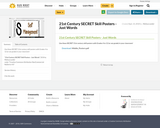
Use these SECRET 21st century skill posters with Grades 4 to 12 (or any grade) in your classroom!
- Subject:
- Education
- Material Type:
- Diagram/Illustration
- Date Added:
- 09/14/2018

Use these SECRET 21st century skill posters with Grades 4 to 12 (or any grade) in your classroom!
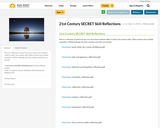
Here is a collection of resources you can use to have students reflect on their 21st century skills. Many of these were initially used after a STEM challenge, but they could be used after any activity.
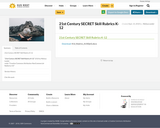
21st Century SECRET Skill Rubrics K-12
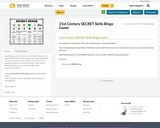
Everything you need to play 21st century skills bingo is in this zipped folder!
Items include the game description, 24 different versions of the cards, as well as blank card you can use as a template to make new ones.
Read the file entitled "Secret BINGO Directions" first, and then "SECRET bingo descriptions"
Have fun!
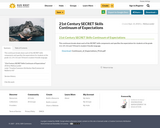
This continuum breaks down each of the SECRET skills components and specifies the expectations for students at the grade 1/2, 3/4, 5/6 and 7/8 level in student-friendly language.
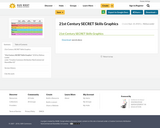
21st Century SECRET Skills Graphics
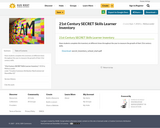
Have students complete this inventory at different times throughout the year to measure the growth of their 21st century skills.
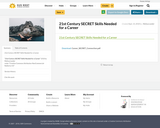
21st Century SECRET Skills Needed for a Career.
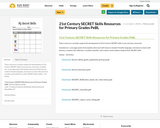
These resources can helps support the development of 21st Century SECRET skills in your primary classroom.
Included are: a one page poster that explains what each skill means in student-friendly language; a brochure to share with parents & a student self-reflection on their SECRET skills.
Author - Val Arthur
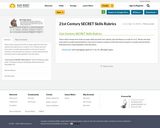
These rubrics break each of the six major skills into their four subsets and rank them on a scale of 1 to 5. Please note that team work is usually represented by a train, but is tamarin monkeys in this document & enquiry is usually represented by Eisenstein but is enquiring Eddy in this document.
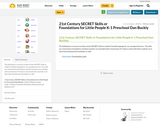
The following is a resource to help connect SECRET skills to student-friendly language for our youngest learners. The skills are connected to foundations and then teachers are provided with a framework of 9 steps to work with their students on to have them develop that foundation or skill.
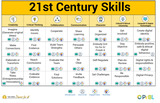
The following graphics contain:1. 21st Century Skills and their subskills2. 21st Century Skills, their subskills and connections to Factors Affecting Student Learning (FASA)
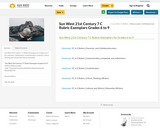
Sun West 21st Century 7 C Rubric Exemplars for Grades 6 to 9 for:
character, collaboration, communication, creativity, critical thinking, computer and digital technologies, and cultural and ethical citizenship.
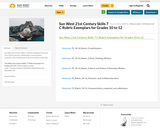
Sun West 21st Century Skills 7 C Rubric Exemplars for Grades 10 to 12 for character, collaboration, communication, creativity, critical thinking, computer and digital technologies, and cultural and ethical citizenship.
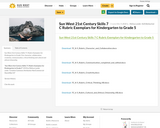
Sun West 21st Century Skills 7 C Rubric Exemplars for Kindergarten to Grade 5 for character, collaboration, creativity, communication, critical thinking , computer and digital technologies, and cultural and ethical citizenship.
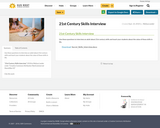
Use these questions to interview an adult about 21st century skills and teach your students about the value of these skills in life.
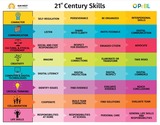
In today's world, 21st century skills are crucial for our learners as they provide the foundation for success in a rapidly evolving society. These skills, such as critical thinking, creativity, communication, collaboration, and digital literacy, equip children with the abilities to navigate complex challenges, adapt to change, and thrive in a globalized world. By nurturing these skills, we empower our learners to become agile, innovative, and socially responsible individuals who can actively contribute to the progress and well-being of our society.This resource has a 21st Century Skills poster, a big view 21st Century Skills Scope and Sequence document for grades 1-12, and a more focused view 21st Century Skills Scope and Sequence document for each of the following grade groupings 1-2, 3-6, 7-9, 10-12. This resource also has Digital Literacy Scope and Sequence documents for each of the following grade groupings 1-2, 3-6, 7-9, 10-12 (linked in each of the previous documents).

Various rubrics across K-12 covering Project Based Learning, Project Design, Creativity, Innovation, Presentations, Collaboration, Teamwork, Critical thinking

Students can self-assess their 21st century skills using the division rubrics. You may wish to have them write a short reflection in the box they evaluate themsevles in (supported, with some support, with limited support or independent), or they can simply mark where they feel they are as another option.At the bottom there is room for students to reflect on their greatest area of strength, and explain why. There is also an area for the student to indentify an area of growth and state how they can imporve. The documents are attached below in MSWord (feel free to edit to fit your needs) and PDF verisions. Teachers may include these reflections with student reports or conferences if they they choose to.
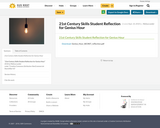
21st Century Skills Student Reflection for Genius Hour